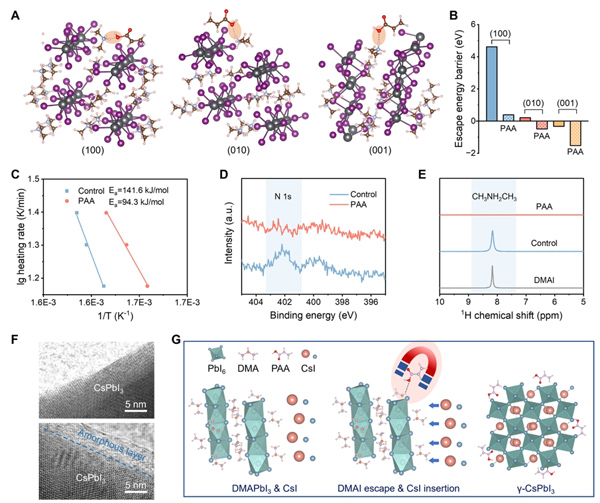The chemical and thermal stable inorganic cesium lead triiodide (CsPbI3) perovskite has shown great potential for photovoltaic applications. DMAPbI3 (dimethylammonium [DMA]) or “HPbI3”-assisted crystallization is effective for the preparation of high-quality β- or γ-phase CsPbI3 films, while it unfortunately causes DMAPbI3 residue and the degradation of photovoltaic performance and stability.
In a recent study published in Joule, the research group led by Prof. HU Jinsong from the Institute of Chemistry of Chinese Academy of Sciences (ICCAS) developed a universal hydrogen-bonding-facilitated DMA extraction strategy for fabricating efficient and stable inorganic CsPbI3 solar cells.
The researchers introduced polyacrylic acid (PAA) into the inorganic CsPbI3 precursors consisting of CsI, PbI2 and DMAI. During the formation of CsPbI3 the PAA could form the hydrogen bonds with DMA, which accelerates the decomposition of DMAPbI3 and DMA extraction. The PAA-added sample exhibited relatively faster phase transformation and achieved the high-quality CsPbI3 film with no DMA residue. Systematic experimental and theoretical investigations revealed that the hydrogen bonding facilitated the DMA extraction by lowering the its escaping energy barrier. The strategy is also applicable to other additives which can form hydrogn bonding with DMA such as polyacrylonitrile (PAN) or poly(4-vinylpyridine) (PVP), etc.

Hydrogen bonding engineered CsPbI3 crystallization (Image by Prof. HU's group)
Combining with stable poly(3-hexylthiophene) (P3HT) hole transport layers, the CsPbI3 PSCs with PAA treatment achieved a power conversion efficiency (PCE) of 20.25%, the highest efficiency reported on CsPbI3 PSCs with a dopant-free P3HT hole transport layer (HTL). The devices demonstrated superior moisture and operational stability in terms of maintaining 94% of their initial PCE after aging at low relative humidity (RH) conditions (<15%) for 10,224 h and over 93% PCE after continuous illumination for 570 h.
Importantly, such strategy enabled the environmentally benign crystallization of CsPbI3, thus significantly extended the fabrication humidity (up to 80% RH) and temperature window, opening up oppertunities for constructing all-inorganic perovskite solar cell modules.

Photovoltaic performance and stability of CsPbI3 PSCs (Image by Prof. HU's group)
contact:
Prof. HU Jinsong
Institute of Chemistry, Chinese Academy of Sciences
Email: hujs@iccas.ac.cn